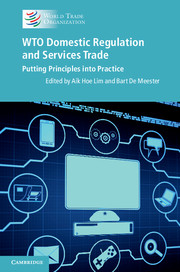Book contents
- Frontmatter
- Contents
- List of contributors
- Foreword
- Disclaimer
- Acknowledgements
- List of abbreviations
- 1 An introduction to domestic regulation and GATS
- Part I Impediments to services trade, regulatory theory and principles
- Part II Legal perspectives on WTO principles and domestic regulations
- Part III Case studies
- 8 Legal services in the United States
- 9 Telecommunications reform in China: fostering competition through state intervention
- 10 Information communications technology: the Mauritian experience of regulation and reform
- 11 Regulation of postal services in a changing market environment: lessons from Australia and elsewhere
- 12 Mobile money services provision in East Africa: the Ugandan experience
- 13 Financial services liberalization and regulation in Japan: implications for future negotiation on market access and domestic regulations
- 14 Domestic regulations in Malaysia’s higher education sector
- 15 Domestic regulations and India’s trade in health services: a study of hospital and telemedicine services
- 16 Operating integrated logistics services in a fragmented regulatory environment: what is the cost?
- 17 Domestic regulation of retail food distribution services in Israel: the missing link between food prices and social protest
- 18 Regulatory impact analysis: addressing the trade and regulatory nexus
- Part IV Concluding remarks
- Index
- References
14 - Domestic regulations in Malaysia’s higher education sector
Published online by Cambridge University Press: 05 April 2014
- Frontmatter
- Contents
- List of contributors
- Foreword
- Disclaimer
- Acknowledgements
- List of abbreviations
- 1 An introduction to domestic regulation and GATS
- Part I Impediments to services trade, regulatory theory and principles
- Part II Legal perspectives on WTO principles and domestic regulations
- Part III Case studies
- 8 Legal services in the United States
- 9 Telecommunications reform in China: fostering competition through state intervention
- 10 Information communications technology: the Mauritian experience of regulation and reform
- 11 Regulation of postal services in a changing market environment: lessons from Australia and elsewhere
- 12 Mobile money services provision in East Africa: the Ugandan experience
- 13 Financial services liberalization and regulation in Japan: implications for future negotiation on market access and domestic regulations
- 14 Domestic regulations in Malaysia’s higher education sector
- 15 Domestic regulations and India’s trade in health services: a study of hospital and telemedicine services
- 16 Operating integrated logistics services in a fragmented regulatory environment: what is the cost?
- 17 Domestic regulation of retail food distribution services in Israel: the missing link between food prices and social protest
- 18 Regulatory impact analysis: addressing the trade and regulatory nexus
- Part IV Concluding remarks
- Index
- References
Summary
Introduction
The growth of private higher education institutions (PHEIs) in Malaysia is politically and economically motivated. Excess demand and the use of ethnic quotas in a limited number of public universities with the implementation of the New Economic Policy in 1970 had raised the potential for inter-ethnic conflicts in multi-ethnic Malaysia. The government therefore utilized private provision to supplement public supply, thereby increasing access and reducing the possibility of inter-ethnic conflicts due to limited access. Over time, the perennial deficit in services trade since independence in 1957 contributed to the idea of using private higher education to reduce student outflows and its negative impact on services trade and, instead, to increase export revenues through inflows of international students. This led to the aspiration to be a regional hub for higher education based on Malaysia’s comparative advantage in terms of costs and language via the use of English in transnational programmes offered in PHEIs, with degrees awarded by parent institutions in developed countries such as Australia and the United Kingdom.
PHEIs grew rapidly with the formal opening up of the education sector in 1996 so that by 2012, there were twenty-nine private universities, twenty-one university colleges, five foreign university branch campuses, and 415 colleges. Intense competition, due to the large number of private providers and a small domestic market, with a population of 28 million, has forced these institutions to look outwards for international students. These institutions are allowed to recruit up to 80 per cent of their enrolment from outside the country. By 2009, Malaysia had captured 2 per cent of the global market for international students and was the eleventh preferred study destination for higher education. In 2010, 72 per cent of international students studying in Malaysia were enrolled in PHEIs, as public universities had capped their enrolment of international students at 5 per cent due to the continued excess demand from local students, as fees in public universities are highly subsidized.
- Type
- Chapter
- Information
- WTO Domestic Regulation and Services TradePutting Principles into Practice, pp. 239 - 253Publisher: Cambridge University PressPrint publication year: 2014



